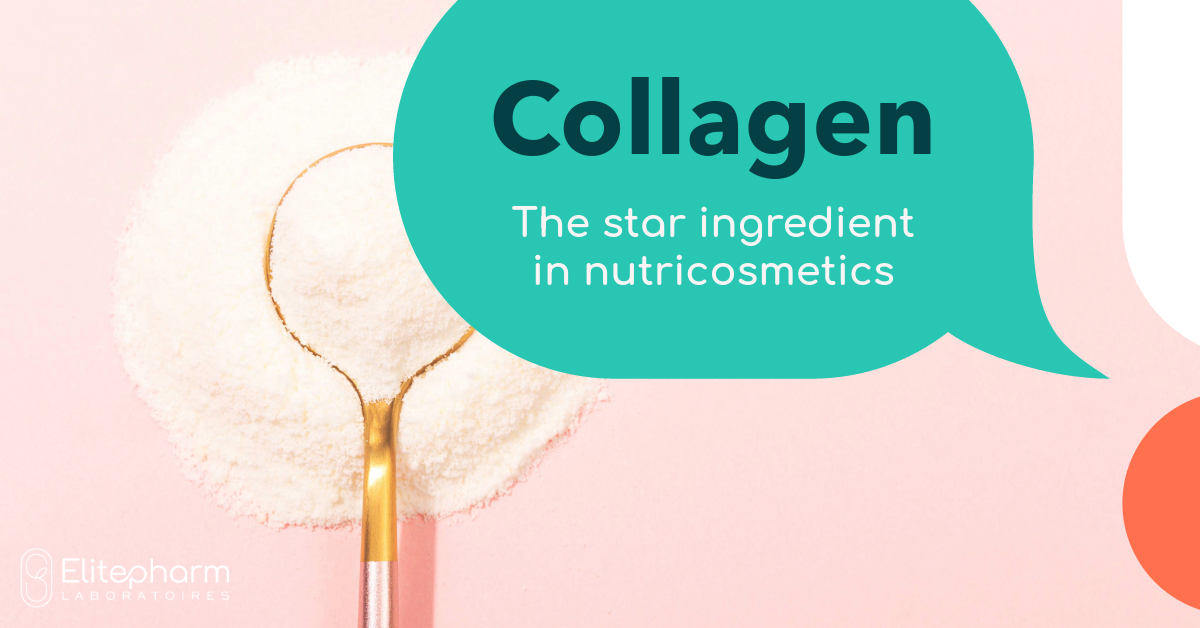Collagen is one of the most trendy and dynamic ingredients in nutraceuticals in recent years, notably found in nutricosmetics. In fact, it is dynamic with a turnover of 9.3 billion euros in 2023 across its three main segments: skin, hair, and sun care. [1] Positioned also for joint health, a star ingredient of upcycling, collagen still has a bright future ahead!
Exploring the Essence of the Collagen Molecule
Structure, localization, and function
Collagen is a structural protein present in the extracellular matrix (ECM) of animal organisms. Connective tissues such as bones, joints, or tendons are the richest in ECM and thus contain significant amounts of collagen. They are not the only ones: a large part of collagen is also found in the skin.
The functions of this molecule are varied but all related to tissues. It ensures their resistance to stretching, their elasticity, and their cohesion.
Depending on the tissue from which collagen is taken, more than twenty different types are identified! Types I and III are the most abundant in the skin, while type II is found in cartilage. The structure of the latter contains hyaluronic acid, among other glycosaminoglycans (GAGs).
Collagen processing methods for nutraceuticals
Once collagen is harvested, various processing methods can be applied to it. This results in final products with different properties:
- Native collagen, simply extracted, is less bioavailable than other forms.
- Gelatin, a denatured form of collagen obtained by chemical extraction processes, is used for its gelling properties and viscosity.
- Collagen peptides, obtained by hydrolysis, are molecules that benefit from better intestinal absorption [2] and better distribution in the human body.[3]
A wide range of collagen sources
Given the diversity of collagen sources available on the market today, it can be challenging for a manufacturer to make a choice.
The first source of collagen, beef, is often chosen for its neutral taste and good solubility. Pork collagen, on the other hand, combines a high similarity to human collagen and a real economic advantage. However, these first two sources may face similar constraints among consumers (religion, ethics, environment), which must be taken into account.
Collagen from poultry is less common despite the distinctive advantage of being accessible to vegetarian consumers. It can be obtained from eggshell membranes.
Collagen is also found in fish and some invertebrates. This marine collagen benefits from a premium and sustainable image that can be counterbalanced by the sourcing cost, lower thermal stability [4], and a taste that can be perceived as strong, depending on the processing method used.
Finally, collagen does not exist in plants, although we frequently hear about “plant-based collagen”! This term refers to attempts at replicating through chemical or biotechnological synthesis, but they remain simplified structures.
The collagen market
In 2023, the global collagen market approached 10 billion euros. This barrier is expected to be quickly surpassed as turnover is expected to continue to grow at a rate of 10.2% per year between 2023 and 2030.[5] With nearly 60% of the market share, foods and beverages dominate the market.[4]
A solution for numerous present-day challenges.
How collagen addresses aging and beauty concerns. [6]
Cartilage is part of the connective tissues, mainly composed of collagen, GAGs, and proteoglycans. Aging and certain lifestyle factors such as overweight and intense sports [7] lead to its gradual weakening, resulting in collagen depletion. This evolution is not without consequences: it affects mobility, the ability to lead an active lifestyle, and ultimately, the independence of individuals. Today, more than 10 million French people — including 65% of those over 65 — suffer from osteoarthritis, the most common joint disease. [8]
Collagen depletion also occurs in the skin: from adulthood, 1% of stocks are lost each year. A rapid evolution that leads to the degradation of 75% of the body’s collagen capital at 80 years [9] old and to a loss of skin firmness.
This collagen, known for its ability to boost collagen production itself [10], is found in many products targeting aging, skin firmness, and elasticity. It is often associated with other ingredients, such as vitamin C or magnesium, which carry claims.
What is the link between collagen and immunity ? [11]
The skin is our first line of immune defense. Collagen peptides, as a constituent of the skin, can help maintain this intact skin barrier and thus promote good health. Furthermore, the role of supporting the immune system by collagen-rich tissues (such as the ECM, epidermis, or bone marrow) is increasingly of interest in research.
Who are the consumers of collagen?
Collagen thus meets several promises, and significant ones at that! These are found in the main reasons for consuming food supplements in France.[1][12] In 2022, 42% of consumers wanted to strengthen their immune system and 24% to look better. It is also worth noting that 33% of food supplement consumers have already used some for enhancing skin and hair beauty.
In France, the number of people aged 75 to 84 will increase by 50% between 2020 and 2030, and life expectancy could reach 96 years for women and 87 years for men by 2050. [13] More than just living longer, the issue will then focus on better living through aging. The promise of support during aging, provided by collagen, should then gain in popularity.
Collagen is an active ingredient that has found its place in nutraceuticals and nutricosmetics. As a faithful companion to these markets, it is expected to remain there while continuing to conquer other sectors. And, whether with collagen coffee, drinks, or even collagen chocolate, the active ingredient seems to have recently initiated a foodification trend.
Expand your range of collagen food supplements today !
[1]Actif’s, Guide AZ 2022, The In and Out market
[2]Is collagen here to stay ? A fresh look at the market and its potential, Frost & Sulivan
[3]The Open Nutraceutical Journal, An overview of the beneficial effects of hydrolysed collagen, as nutraceutical on skin properties: scientific background and clinical studies, Sibila et al., 2015
[4]Wang H. A Review of the Effects of Collagen Treatment in Clinical Studies. Polymers (Basel). 2021 Nov 9;13(22):3868. doi: 10.3390/polym13223868. PMID: 34833168; PMCID: PMC8620403.
[5]Collagen Market Size, Share & Trends Analysis Report, Application Insights, Grand View Research, 05/2023
[6]Actif’s, Guide A-Z, Du collagène pour la santé des articulations, de la peau et des tissus conjonctifs, 2020.
[7]Actif’s Guide A-Z, Les multiples bienfaits du collagène pour la santé articulaire, 2019.
[8]Inserm, Arthrose : comment atténuer la douleur?, 04/2023
[9]Ce que vous devez savoir sur le collagène, Nutri&Co,
[10]Collagen peptides and the related synthetic peptides: A review on improving skin health, 2021.
[11]Actif’s Guide A-Z, Collagène, 2021
[12]Actif’, Guide A-Z, Le consommateur français de compléments alimentaires, 2022
[13]Vieillissement de la société française : réalité et conséquences, Haut-Commissariat au Plan

